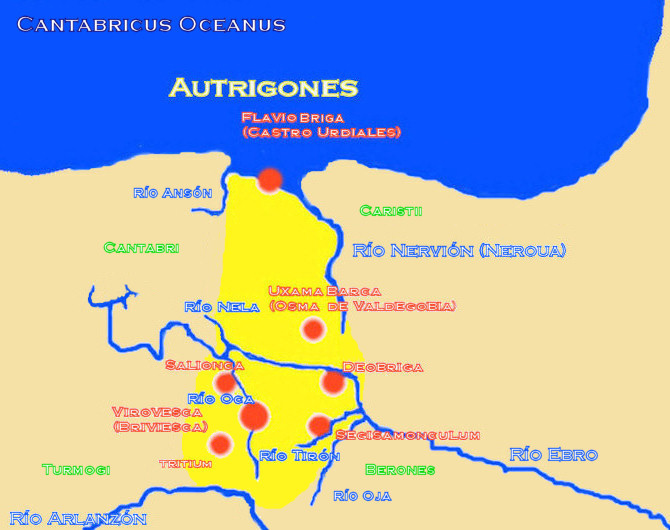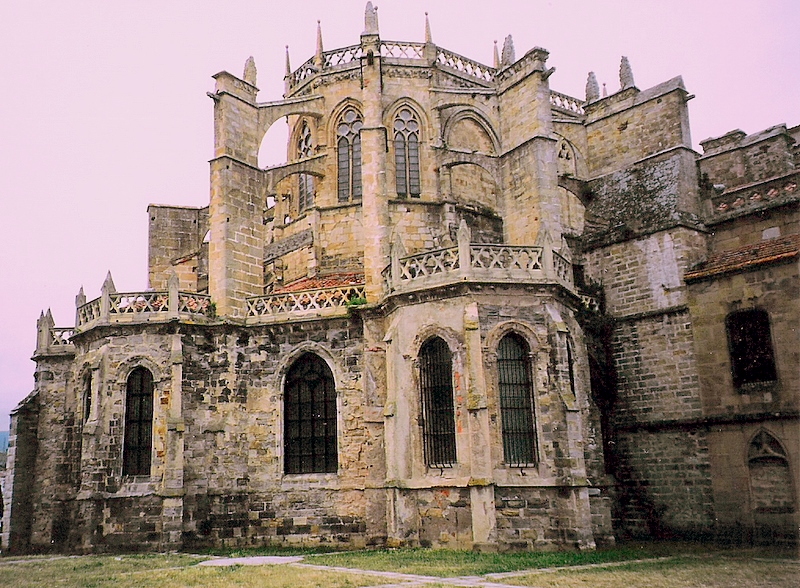|
Autrigones
The Autrigones were a pre-Roman tribe that settled in the north of the Iberian Peninsula, in what today is the western Basque Country (western regions of Biscay and Álava) and northern Burgos and the East of Cantabria, Spain. Their territory limited with the Cantabri territory at west, the Caristii at east, the Berones at the southeast and the Turmodigi at the south. It is discussed whether the Autrigones were Celts, theory supported by the existence of toponyms of Celtic origin, such as ''Uxama Barca'' and other with ''-briga'' endings and that eventually underwent a Basquisation along with other neighboring tribes such as the Caristii and Varduli. Location Roman historians as Pomponius Mela and Pliny the Elder located them in the northern region of present-day province of Burgos. Pliny the Elder writes about the "ten states of the Autrigones" and says the only ones worth mentioning are ''Tritium Autrigonum'' ( Monasterio de Rodilla, Burgos) and ''Virovesca'' (possibly the p ... [...More Info...] [...Related Items...] OR: [Wikipedia] [Google] [Baidu] |
Briviesca
Briviesca is a municipality and a Spanish city located in the north of the Iberian Peninsula, head of the judicial district of Briviesca, capital of the comarca of La Bureba and province of Burgos, autonomous community of Castile and León. According to the demographic data of 2017, the municipality has 6,861 inhabitants, being the 4th most populated in the province. The municipality of Briviesca is made up of five towns: Briviesca (seat or capital), Cameno, Quintanillabón, Revillagodos and Valdazo. The first settlements date back to the 1st century BC, when the Autrigones, that extended by all the current region of the Bureba and the Upper Ebro valley, established here their capital. Subsequently Briviesca, by then called Virovesca, was already considered an important nucleus of population, where the Romans inhabited in the crossroads of two important Roman roads. This location, and the boom, in the Middle Ages, of the Camino de Santiago, made Briviesca grow little by littl ... [...More Info...] [...Related Items...] OR: [Wikipedia] [Google] [Baidu] |
Varduli
The Varduli were a pre-Ancient Rome, Roman tribe settled in the north of the Iberian Peninsula, in what today is the western region of the Basque Country (greater region), Basque Country. Their historical territory corresponds with the current Basque language, Basque area; however, it is not entirely clear whether the Varduli were actually Aquitanians, related to the Vascones, or Celts, Celticized tribes, related to Cantabri or Celtiberians which later underwent Late Basquisation, Basquisation. It seems probable the group shared the proto-Basque cultural-ethnic identity of the people of this region. Etymology Their ethnonym ''Varduli'' is connected with an area that is referred to in documents from the early Middle Ages as Bardulia, which is mentioned as the cradle of Old Castile, following the decline of the Kingdom of Navarre, Navarrese Kingdom. Julio Caro Baroja, a Basque anthropologist and linguist asserted in his works that the term ''Varduli'' was not of Basque langua ... [...More Info...] [...Related Items...] OR: [Wikipedia] [Google] [Baidu] |
Caristii
The Caristii were a pre-Ancient Rome, Roman tribe settled in the north of the Iberian Peninsula, in what today are known as the historical territories of Biscay and Álava, in the Basque Country (autonomous community), Basque Country, northern Spain. Origins Their historical territory today corresponds very well with the extension of the Biscayan dialect of the Basque language, however it is discussed whether the Caristii were actually Aquitanians, related to the Vascones, or if they were Celts, related to tribes such as the Cantabri and Celtiberians and that later suffered a Late Basquisation, Basquisation. History The Caristii are first mentioned by Ancient Rome, Roman sources; Pliny the Elder names them ''Carietes'' and places them in the Basque interior territories, what today is the southernmost regions of the Basque Country (autonomous community), Basque Country, while Ptolemy places them between the river Deba (river), Deba and Nervión, present-day provinces of Biscay a ... [...More Info...] [...Related Items...] OR: [Wikipedia] [Google] [Baidu] |
Turmodigi
The Turmodigi were a pre- Roman ancient CelticStrabo, ''Geographica'', III, 4, 12. people of northern Spain who occupied the area within the Arlanzón and Arlanza river valleys in the 2nd Iron Age. Origins The ancestors of the Turmodigi arrived at the Iberian Peninsula in the wake of the earlier Autrigones-Belgae migration at the 4th century BC, which settled in the area between the Arlanzón and Arlanza rivers. The neighbouring tribes surrounding the Turmodigi are mentioned by classic sources as being Celtic, as attested by the personal name 'Tormogus' in some local epigraphic sources. Designated ''Turmodigi'' by the Roman geographer Pliny the Elder, they are also mentioned in other Roman texts under the names ''Turmogi'' or ''Curgoni'', and in the Greek ones as ''Murbogoioi'' or ''Mourbogoi'' (Ancient Greek: Μούρβογοι). Culture Archeology has related them with the early Iron Age " Bernorio- Miraveche" cultural group of northern Burgos and Palencia provinces. M ... [...More Info...] [...Related Items...] OR: [Wikipedia] [Google] [Baidu] |
Province Of Biscay
Biscay ( ; ; ), is a province of the Basque Autonomous Community, heir of the ancient Lordship of Biscay, lying on the south shore of the eponymous bay. The capital and largest city is Bilbao. Biscay is one of the most renowned and prosperous provinces of Spain, historically a major trading hub in the Atlantic Ocean since medieval times and, later on, one of the largest industrial and financial centers of the Iberian Peninsula. Since the extensive deindustrialization that took place throughout the 1970s, the economy has come to rely more on the services sector. Etymology It is accepted in linguistics (Koldo Mitxelena, etc.) that ''Bizkaia'' is a cognate of ''bizkar'' (cf. Biscarrosse in Aquitaine), with both place-name variants well attested in the whole Basque Country and out meaning 'low ridge' or 'prominence' (''Iheldo bizchaya'' attested in 1141 for the Monte Igueldo in San Sebastián). Names ''Bizkaia'' ''Bizkaia'' is the official name, and it is used on official ... [...More Info...] [...Related Items...] OR: [Wikipedia] [Google] [Baidu] |
Berones
The Berones were a pre-Roman Celtic people of ancient Spain, although they were not part of the Celtiberians. They lived north of the latter and close to the Cantabrian Conisci in the middle Ebro region between the Tirón and Alhama rivers. Origins The ancestors of the Berones were Celts who migrated from Gaul to the Iberian Peninsula around the 4th century BC, to settle in La Rioja and the southern parts of the Soria, Álava and Navarre provinces. Location A stock-raising people that practiced transhumance, their capital was ''Varia'' or ''Vareia'' ( Custodia de Viana; Celtiberian-type mint: ''Uaracos Auta''?), situated near Logroño at the middle Ebro in La Rioja. and controlled the towns of ''Libia'' ( Herramélluri or Leiva – La Rioja), ''Tritium Megallum'' ( Tricio), ''Bilibium'' ( Bilibio, near Conchas de Haro – La Rioja) and ''Contrebia Leukade'' ( Aguillar del Rio Alhama – La Rioja). History Allies of the Autrigones, the Berones appear to have kept th ... [...More Info...] [...Related Items...] OR: [Wikipedia] [Google] [Baidu] |
Cantabria
Cantabria (, ; ) is an autonomous community and Provinces of Spain, province in northern Spain with Santander, Cantabria, Santander as its capital city. It is called a , a Nationalities and regions of Spain, historic community, in its current Statute of Autonomy. It is bordered on the east by the Basque Country (autonomous community), Basque autonomous community (Biscay, province of Biscay), on the south by Castile and León (Province of León, provinces of León, Palencia (province), Palencia and Province of Burgos, Burgos), on the west by the Asturias, Principality of Asturias, and on the north by the Cantabrian Sea, which forms part of the Bay of Biscay. Cantabria belongs to ''Green Spain'', the name given to the strip of land between the Bay of Biscay and the Cantabrian Mountains, so called because of its particularly lush vegetation, due to the wet and temperate oceanic climate. The climate is strongly influenced by Atlantic Ocean winds trapped by the mountains; the averag ... [...More Info...] [...Related Items...] OR: [Wikipedia] [Google] [Baidu] |
Castro Urdiales
Castro Urdiales () is a seaport of northern Spain, in the autonomous community of Cantabria, situated on the Bay of Biscay. Castro Urdiales is a modern town, although its castle and the Gothic-style parish church of Santa María de la Asunción, date from the Middle Ages. Its chief industries are tourism, fishing, and fish preservation, oil-packing of fish, especially sardines and anchovies. The Lolin and La Castreña anchovy canning factories serve as a reminder of the town's closeness to this industry and its proximity to the sea. Although the number of people registered in the town is around 32,000, the summer population can double or even triple this figure. The town is popular because of its beaches and scenic harbor. History Castro Urdiales was originally called Portus Amanum, and was the chief city of the Autrigones. In AD 74 a Ancient Rome, Roman Colonia (Roman), colony was established under the name Flaviobriga, during the reign of emperor Vespasian. It was most likely ... [...More Info...] [...Related Items...] OR: [Wikipedia] [Google] [Baidu] |
Late Basquisation
Late Basquisation is a minority hypothesis that dates the arrival of the first speakers of the Basque language in northeastern Iberia from Aquitaine to the 5th or 6th century AD – as opposed to the mainstream view of it being the last remaining descendant of one of the pre-Indo-European languages of Prehistoric Europe. History The Basque language is a language isolate that has survived the arrival of Indo-European languages in western Europe. Basque (and its ancestors or closely related languages such as Aquitanian) historically occupied a much larger territory, including parts of modern-day Béarn, Aragon, Rioja, Castile south of the Pyrenees, and large parts of modern-day Gascony to the north. Hypothesis The "Late Basquisation" hypothesis set the historical geographical spread of the Basque or the proto-Basque language later in history. It suggests that at the end of the Roman Republic and during the first centuries of the Empire, migration of Basque-speakers from Aqui ... [...More Info...] [...Related Items...] OR: [Wikipedia] [Google] [Baidu] |
Quintus Sertorius
Quintus Sertorius ( – 73 or 72 BC) was a Roman general and statesman who led a large-scale rebellion against the Roman Senate on the Iberian Peninsula. Defying the regime of Sulla, Sertorius became the independent ruler of Hispania for most of a decade until his assassination. Sertorius first became prominent during the Cimbrian War fighting under Gaius Marius, and then served Rome in the Social War. After Lucius Cornelius Sulla blocked Sertorius' attempt at the plebeian tribunate , following Sulla's consulship, Sertorius joined with Cinna and Marius in the civil war of 87 BC. He led in the assault on Rome and restrained the reprisals that followed. During Cinna's repeated consulships he was elected praetor, likely in 85 or 84 BC. He criticised Gnaeus Papirius Carbo and other Marians' leadership of the anti-Sullan forces during the civil war with Sulla and was, late in the war, given command of Hispania. In late 82 BC Sertorius was proscribed by Su ... [...More Info...] [...Related Items...] OR: [Wikipedia] [Google] [Baidu] |






